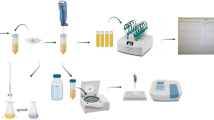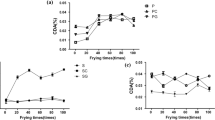Abstract
This study compared the antioxidant properties of oregano essential oil (OEO) and butylated hydroxytoluene (BHT) alone and when combined. The principal components in OEO were gamma terpinene (25.1 g/100 g), terpinen-4-ol (16.7 g/100 g), and carvacrol (16.2 g/100 g). OEO showed 60% DPPH inhibition and 10 mg/g total phenolic compounds. The antioxidant capacity of OEO (0.02, 0.10, and 0.20 g/100 g) and BHT (0.01 and 0.02 g/100 g) and their combinations were tested in sunflower oil oven-heated at 60 °C, by measuring the chemical (peroxide value, p-anisidine value, and conjugated dienes) and volatile (hexanal, 2-heptanal, and 2,4-decadienal) indicators over 14 days. The combined samples (oregano essential oil and BHT) showed the greatest protection against lipid oxidation. On day 14, the peroxide value of the control (without added antioxidants), OEO (0.02 g/100 g), BHT (0.01 g/100 g), and OEO + BHT (0.02 + 0.01 g/100 g) treatments decreased in the order of 136.36, 102.68, 83.24, and 41.37 meqO2/kg, respectively, for example. In the consumer sensory test, samples containing OEO at 0.02 and 0.10 g/100 g attained greater acceptance scores (7.3 and 6.7, respectively, on a 9-point hedonic scale) as compared with the control (6.1). Discriminative duo–trio testing presented significant differences between all OEO-containing samples relative to the control. The synergistic antioxidant activity between OEO (termination-enhancing antioxidant) and BHT (chain-breaking antioxidant) demonstrates an alternative approach to impede lipid oxidation in foods, by decreasing the use of synthetic compounds in the food industry.



Similar content being viewed by others
References
Adams RP (1995) Identification of essential oils by ion trap mass spectroscopy. Allured Press, Carol Stream
Adams A, Kruma Z, Verhé R, De Kimpe N, Kreicbergs V (2011) Volatile profiles of rapeseed oil flavored with basil, oregano and thyme as a function of flavoring conditions. J Ame Oil Chem Soc 88(2):201–212
Aladedunye F, Przybylski R (2013) Frying stability of high oleic sunflower oils as affected by composition of tocopherol isomers and linoleic acid content. Food Chem 141:2373–2378
Amorati R, Foti M, Valgimigli L (2013) Antioxidant activity of essential oils. J Agric Food Chem 61:10835–10847
AOAC (1980) Official methods of analysis of the AOAC. Horwitz W (ed) 13th edn. Washington, DC
Asensio CM, Nepote V, Grosso NR (2012) Sensory attribute preservation in extra virgin olive oil with addition of oregano essential oil as natural antioxidant. J Food Sci 77:294–301
Asensio CM, Nepote V, Grosso NR (2013) Consumers’ acceptance and quality stability of olive oil flavoured with essential oils of different oregano species. I J Food Sci Technol 48:2417–2428
Baschieri A, Ajvazi MD, Tonfack JLF, Valgimigli L, Amorati R (2017) Explaining the antioxidant activity of some common non-phenolic components of essential oils. Food Chem 232:656–663
Belitz HD, Grosch W, Schielberle P (2009) Food chemistry. Springer, Berlin
Boskou D, Elmadfa I (2011) Frying of food. CRC Press, Boca Raton
Castilho PC, Savluchinske-Feio S, Weinhold TS, Gouveia SC (2012) Evaluation of the antimicrobial and antioxidant activities of essential oils, extracts and their main components from oregano from Madeira Island, Portugal. Food Control 23(2):552–558
Choi HS, Song HS, Ukeda H, Sawamura M (2000) Radical scavenging activities of citrus essential oils and their compoents. Detection using 1,1 diphenyl-2-picrylhydrazyl. J Agric Food Chem 48:4156–4161
Chouliara E, Karatapanis A, Savvaidis IN, Kontominas MG (2007) Combined effect of oregano essential oil and modified atmosphere packaging on shelf-life extension of fresh chicken breast meat, stored at 4 °C. Food Microbiol 24:607–617
COI (2001) Método de análisis, prueba espectrofotométrica en el ultravioleta. Document COI/T, 20/Doc no 19/Rev. 1. International Olive Oil Council (IOOC), Madrid
Dambolena JS, Zunino MP, Lucini EI, Olmedo R, Banchio E, Bima P, Zygadlo JA (2010) Total phenolic content, radical scavenging properties and essential oil composition of origanum species from different populations. J Agric Food Chem 58:1115–1120
Dima C, Dima S (2015) Essential oils in foods: extraction, stabilization, and toxicity. Curr Opin Food Sci 5:29–35
Feng X, Ng VK, Mikš-Krajnik M, Yang H (2017a) Effects of fish gelatin and tea polyphenol coating on the spoilage and degradation of myofibril in fish fillet during cold storage. Food Bioprocess Technol 10:89–102
Feng X, Zhu Y, Liu Q, Lai S, Yang H (2017b) Effects of bromelain tenderization on myofibillar proteins, texture and flavor of fish balls prepared from golden pomfret. Food Bioprocess Technol 10(10):1918–1930
Foti MC (2015) Use and abuse of the DPPH Radical. J Agric Food Chem 63:8765–8776
Gorji SG, Smyth HE, Sharma M, Fitzgerald M (2016) Lipid oxidation in mayonnaise and the role of natural antioxidants: a review. Trends Food Sci Technol 56:88–102
Guillen MD, Goicoechea E (2008) Formation of oxygenated α, β-unsaturated aldehydes and other toxic compounds in sunflower oil oxidation at room temperature in closed receptacles. Food Chem 111:157–164
Guimaraes R, Sousa MJ, Ferrerira ICFR (2010) Contribution of essential oils and phenolics to the antioxidant properties of aromatic plants. Ind Crops Prod 32:152–156
Hamdo HH, Khayata W, Al-Assaf Z (2014) Synergistic effect of combined some natural and synthetic antioxidants to increase oxidative stability using DPPP test. Int J Chem Tech Res 6(4):2539–2545
IUPAC (1987) Method number 2.504. Determination of the p-anisidine value. In: Paquot C, Hautfenne A (eds) Standard methods for the analysis of oils, fats and derivatives, 7th edn. Blackwell Scientific Publications, Oxford
Jonhson RA, Wichern DW (1998) Applied multivariate statistical analysis. Pretince Hall, Englewook Cliffs
Lester GE, Lewers KS, Medina MB, Saftner RA (2012) Comparative analysis of strawberry total phenolics via Fast Blue BB vs. Folin-Ciocalteu: assay interference by ascorbic acid. J Food Compost Anal 27:102–107
Marteau C, Favier D, Nardello-Rataj V, Aubry JM (2014) Dramatic solven effect on the synergy between α-tocopherol and BHT antioxidants. Food Chem 160:190–195
Ngo TC, Dao DQ, Thong NM, Nam PC (2016) Insight into the antioxidant properties of non-phenolic terpenoids contained in essential oils extracted from the buds of Cleistocalyx operculatus: a DFT study. RSC Adv 6:30824–30834
Olmedo RH, Asensio C, Nepote V, Mestrallet MG, Grosso NR (2009) Chemical and sensory stability of fried-salted peanuts flavored with oregano essential oil and olive oil. J Sci Food Agric 89:2128–2136
Olmedo RH, Nepote V, Grosso NR (2012a) Aguaribay and Cedron essential oils as natural antioxidants in oil-roasted and salted peanuts. J Am Oil Chem Soc 89(12):2195–2205
Olmedo RH, Nepote V, Grosso NR (2012b) Sensory and chemical stability in coated peanuts with the addition of essential oils and synthetic antioxidants. Int J Fats Oils 63(1):5–13
Olmedo RH, Nepote V, Grosso NR (2013) Preservation of sensory and chemical properties in flavored cheese prepared with cream cheese base using oregano and rosemary essential oils. LWT-Food Sci Technol 53:409–417
Olmedo R, Nepote V, Grosso NR (2014) Antioxidant activity of fractions from oregano essential oils obtained by molecular distillation. Food Chem 156:212–219
Olmedo R, Asensio CM, Grosso NR (2015) Thermal stability and antioxidant activity of essential oil from aromatic plants farmed in Argentina. Ind Crops Prod 69:21–28
Pan Y, Zhu J, Wang H, Zhang X, Zhang Y, He C, Ji X, Li H (2007) Antioxidant activity of ethanolic extract of Cortex fraxini and use in peanut oil. Food Chem 103:913–918
Roginsky V, Lissi EA (2005) Review of methods to determine chain-breaking antioxidant activity in food. Food Chem 92:235–254
Sharma OP, Bhat TK (2009) DPPH antioxidant assay revisited. Food Chem 113:1202–1205
Shearn CT, Fritz KS, Thompson JA (2011) Protein damage from electrophiles and oxidans in lung of mice chronically exposed to the tumor promoter butylated hydroxytoluene. Chem-Biol Interact 192:278–286
Tohidi B, Rahimmalek M, Arzani A (2017) Essential oil composition, total phenolic, flavonoid contents and antioxidant activity of Thymus species collected from different regions of Iran. Food Chem 220:153–161
Wang S, Adhikari K, Hung YC (2017) Effects of short storage on consumer acceptability and volatile compound profile of roasted peanuts. Food Pack Shelf Life 13:27–34
Yan F, Azizi A, Janke S, Schwarz M, Zeller S, Honermeier B (2016) Antioxidant capacity variation in the oregano (Origanum vulgare L.) collection of the German National Genebank. Ind Crops Prod 92:19–25
Yu X, Ang HC, Yang H, Zheng C, Zhang Y (2017) Low temperature cleanup combined with magnetic nanoparticle extraction to determine pyrethroids residue in vegetables oils. Food Control 74:112–120
Yu X, Li Z, Zhao M, Lau SCS, Tan HR, Teh WJ, Yang H, Zheng C, Zhang Y (2019) Quantification of aflatoxin B1 in vegetable oils using low temperature clean-up followed by immune-magnetic solid phase extraction. Food Chem 275:390–396
Zhang L, Chen F, Lai S, Wang H, Yang H (2018) Impact of soybean protein isolate-chitosan edible coating on the softening of apricot fruit during storage. LWT-Food Sci Technol 96:604–611
Acknowledgements
This work was supported by Consejo Nacional de Investigaciones Científicas y Técnicas (CONICET) and Secretaria de Ciencia y Tecnología de la Universidad Nacional de Córdoba (SECYT-UNC).
Author information
Authors and Affiliations
Corresponding author
Ethics declarations
Conflict interest
The authors declare that they have no conflict of interest.
Additional information
Publisher's Note
Springer Nature remains neutral with regard to jurisdictional claims in published maps and institutional affiliations.
Rights and permissions
About this article
Cite this article
Olmedo, R., Ribotta, P. & Grosso, N.R. Decrease of chemical and volatile oxidation indicators using oregano essential oil combined with BHT in sunflower oil under accelerated storage conditions. J Food Sci Technol 56, 2522–2535 (2019). https://doi.org/10.1007/s13197-019-03731-8
Revised:
Accepted:
Published:
Issue Date:
DOI: https://doi.org/10.1007/s13197-019-03731-8




